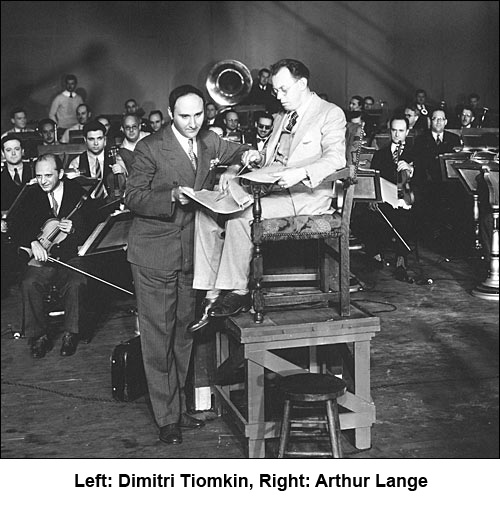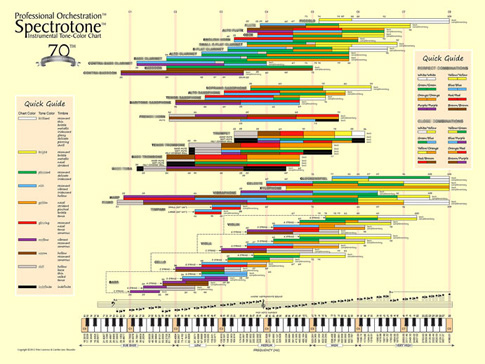The Genius of Arthur Lange
The Spectrotone Instrumental Tone-Color Chart™ was originally created by Academy Award nominee Arthur Lange, Music Director of the MGM Music Department and other studios.

Arthur Lange was a songwriter, composer, orchestrator and conductor. He composed music for over 120 films, and orchestrated 105 more. He was nominated four times for an Oscar. In 1929, he became head of the music department at MGM. Throughout his career, he was music director at several studios and in 1947 organized the Santa Monica Civic Symphony which he conducted. He also helped create ASMAC, the American Society of Music Arrangers and Composers. He taught at the Los Angeles Conservatory of Music which later became Cal Arts.
Arthur Lange's Spectrotone Chart has daily practical use for both live and electronic scoring, and mixing, and could be described as the Rosetta Stone of orchestration.

About the Spectrotone Instrumental Tone-Color Chart™
In Arthur Lange's own words, the Spectrotone Chart is, "a colorgraphic exposition of tone-color combinations and balance as practiced in modern orchestration." The approach and method of the Spectrotone Chart, and its two accompanying PDF training guides, are the result of many years' experience gained by Arthur Lange in film, radio, and concert performances that he tested and proved to be practical and effective.
This updated and expanded 70th Anniversary Edition of Lange's Spectrotone Chart is organized across the span of a keyboard (shown at the bottom of the chart) with each key numbered with its MIDI Note Number. Immediately above the keyboard, each note is shown in its corresponding position on a mini-music staff. This organization makes the chart useful to both music and non-music readers alike. Below the keyboard, Hz frequencies have been added for each note so that its full potential can also be realized in recording and mixing.
Using the Spectrotone Chart you'll learn how to create effective orchestral combinations by understanding which instruments will blend well together in which registers, or which instruments will provide a more contrasting tone-color when placed together. You'll also learn starting insights on orchestral balance within each section of strings, brass and winds.
The tone-color choices make a lot of sense enabling not only precision orchestral combinations, live and electronic, but also providing a gracious way to communicate with producers and directors in a language they’ll understand since each color has a single adjective to describe it:
White = Brilliant
Yellow = Bright
Green = Pleasant
Blue = Rich
Orange = Golden
Red = Glowing
Brown = Warm
Purple = Mellow
Grey = Dull
Black = Indefinite
The eight colors convey the instrument's tone-color and its quality, with the lowest pitches colored Purple (mellow) and the highest, White (brilliant). Two additional colors of gray and black indicate notes that will have a "dull" or "indefinite" tone-color to them.
Each tone-color has an additional timbre description that changes depending on the type of articulation used. In your PDF Guides you're given a chart of Articulation Tables by tone-color, by instrument, that show how the timbre can change, and also how this will affect the intensity and carrying power of that instrument. You'll know when an instrument in a particular register will be strong in intensity, or when it will be weak and possibly need reinforcing by another instrument.
The Spectrotone Instrumental Tone-Color Chart has applications to any style of music that makes use of orchestral instruments. Use it when arranging, composing, recording or mixing. With its color coded approach, you can quickly work out combinations by instrument, by range, and by specific notes.
Combination possibilities include:
1. within a single section
2. combining sections
3. solo instruments contrasted against an ensemble
4. combinations that work well in unisons, octaves, thirds, sixths, and other open intervals
5. combinations that work well in multipart harmony
You can quickly work out any of the above possibilities for yourself using the Spectrotone Chart.
Combinations are organized by four broad categories:
1. Perfect
2. Close
3. Complementary
4. Remote
Each of these Combinations of Perfect, Close, Complementary, and Remote, are explained in the accompanying PDF guides so you'll know how to achieve them yourself.
The Spectrotone Chart is a must have for all arrangers, composers and recording engineers!
The Spectrotone Chart is a digital download item, that can be used as an on-screen reference, or printed out on a variety of different sized papers. On a home printer, the printer will resize so you can print out on 8.5"x11", A4, and other papers.
You can also take the Spectrotone Chart to a print store, such as the US/UK office supplies store, Staples, who have a poster-printer on site. On printout, the Spectrotone Chart is designed for a standard 18" x 24" poster sheet.
Two (2) detailed PDF training guides for the Spectrotone Chart are included in your downloads, along with a Print Release form and printing instructions.
ADDITIONAL VIDEO TRAINING
For those who want to go further with the Spectrotone Instrumental Tone-Color Chart, the following additional training is available. Click on the course names for more information:
Visual Orchestration 1: Spectrotone Course - Basic Edition
If you've already purchased the Spectrotone Chart, you can add to your training with this short course in orchestration that's based on using the Spectrotone Chart. Includes seven downloadable video lectures covering 3.7 hours of training.
Visual Orchestration 1: Spectrotone Course - Master Edition
If you don't already own the Spectrotone Chart and want to get it with the additional 3.7 hours of video training, order this special Master Edition package.
Visual Orchestration 1: Spectrotone Course - Advanced Edition
If you don't already own the Spectrotone Chart, we've put together a special Advanced Edition training package that includes the Spectrotone Chart, the 3.7 hours of video training, AND our Professional Orchestration 10-hour MP3 Concert Audio Pack (which is also available separately), that includes an average 20-minute concert for each featured orchestral instrument, to really help train your ears.